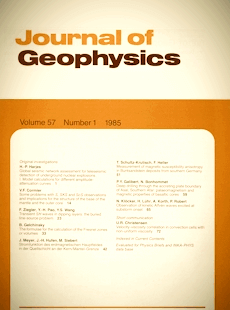Seismic modelling by methods of the theory of edge waves
Article Sidebar

Vols. 1-18 (1924-1944), ISSN 0044-2801
Main Article Content
Abstract
This paper deals with the computation of wavefields in 3-D inhomogeneous media containing structural elements such as pinch-outs, vertical and oblique contacts, faults, etc. The approach is based on the theory of edge waves. The total wavefield is considered as the superposition of two parts. The first part is described by the ray method. It has discontinuities because of its shadow boundaries. The second part is a superposition of two types of diffracted waves, caused by the edges and vertices of interfaces. This part smooths the above-mentioned discontinuities so that the total wavefield is continuous. Of special importance is the mathematical form of the amplitudes of diffracted waves, described with unified functions of eikonals. In fact, it allows all additional computations to be considered by finding the eikonals of diffracted waves. A modification of the ray method including diffraction by edges and vertices is described. A generalization of the concept of edge waves for caustic situations is given — the method of superposition of edge/tip waves. The result of such a generalization no longer supplements the geometrical seismic description, but completely replaces it by a new description valid for a broader class of wave phenomena (reflection/refraction, diffraction on edges and vertices, formation of caustics, etc.).
 ARK: https://n2t.net/ark:/88439/y067930
ARK: https://n2t.net/ark:/88439/y067930
Permalink: https://geophysicsjournal.com/article/236
Article Details
References
Aizenberg, A.M., Klem-Musatov, K.D. (1980) Calculation of wave fields by the method of superposition of the edge waves. Soviet Geol. and Geophys. 21:79-94
Babich, V.M., Alekseyev, A.S. (1958) A ray method of computing wave front intensities. Bull. Acad. Sci. USSR, Geophys. Ser. 1:9-15
Babich, V.M., Buldyrev, V.S. (1972) Asymptotic methods in problems of diffraction of short waves (In Russian). Nauka, Moscow
Born, M., Wolf, E. (1968) Principles of optics. Pergamon Press, Oxford
Červeny, V. (1983) Synthetic body wave seismograms for laterally varying layerd structures by the Gaussian beam method. Geophys. J. R. Astron. Soc. 73:389-426
Červeny, V., Molotkov, I.A., Psenčik, I. (1977) Ray method in seismology. Charles University, Prague
Claerbout, J.F. (1976) Fundamentals of geophysical data processing. McGraw-Hill, New York
Clemmow, P.S., Senior, T.B.A. (1953) A note on generalized Fresnel integral. Proc. Camb. Phil. Soc. 9:570-572
Felsen, L.B., Marcuvitz, N. (1973) Radiation and scattering of waves. Prentice-Hall, Englewood Clifts, New Jersey
Fertig, J., Muller, G. (1979) Approximate diffraction theory for transparent half-planes with application to seismic-wave diffraction at coal seams. J. Geophys. 46:349-367
Fock, V.A. (1965) Electromagnetic diffraction and propagation problems. Pergamon Press, New York
Hilterman, F.J. (1982) Interpretative lessons from three-dimensional modelling. Geophysics 47:784-808
Karal, F.C., Keller, J.B. (1959) Elastic wave propagation in homogeneous and inhomogeneous media. J. Acoust. Soc. Am. 31:694-705
Keller, J.B. (1962) A geometrical theory of diffraction. J. Opt. Soc. Am. 52:116-130
Kennett, B.L.N. (1984) Reflection operator methods for elastic waves. I - Irregular interfaces and regions. Wave Motion (In press)
Klem-Musatov, K.D. (1980) The theory of edge waves and its applications in seismology (In Russian). Nauka, Novosibirsk
Klem-Musatov, K.D. (1981a) Scattering of waves of a point fracture of a diffracting edge. Soviet Geol. and Geophys. 22:118-127
Klem-Musatov, K.D. (1981b) Asymptotic formulae for the amplitude of wave scattered by a salient point on a diffracting edge. Soviet Geol. and Geophys. 22:108-114
Klem-Musatov, K.D., Aizenberg, A.M. (1984) Ray method and the theory of edge waves. Geophys. J. R. Astron. Soc. 79:35-50
Klem-Musatov, K.D., Aizenberg, A.M., Klem-Musatova, G.A. (1982) An algorithm for mathematical modelling of threedimensional diffraction fields. Soviet Geol. and Geophys. 23:116-121
Popov, M.M. (1981) A new method of computations of wave fields in high-frequency approximation. Report LOMI AN SSSR, E-1-81 Leningrad
Trorey, A.W. (1977) Diffraction for arbitrary source-receiver locations. Geophysics 42:1177-1182











